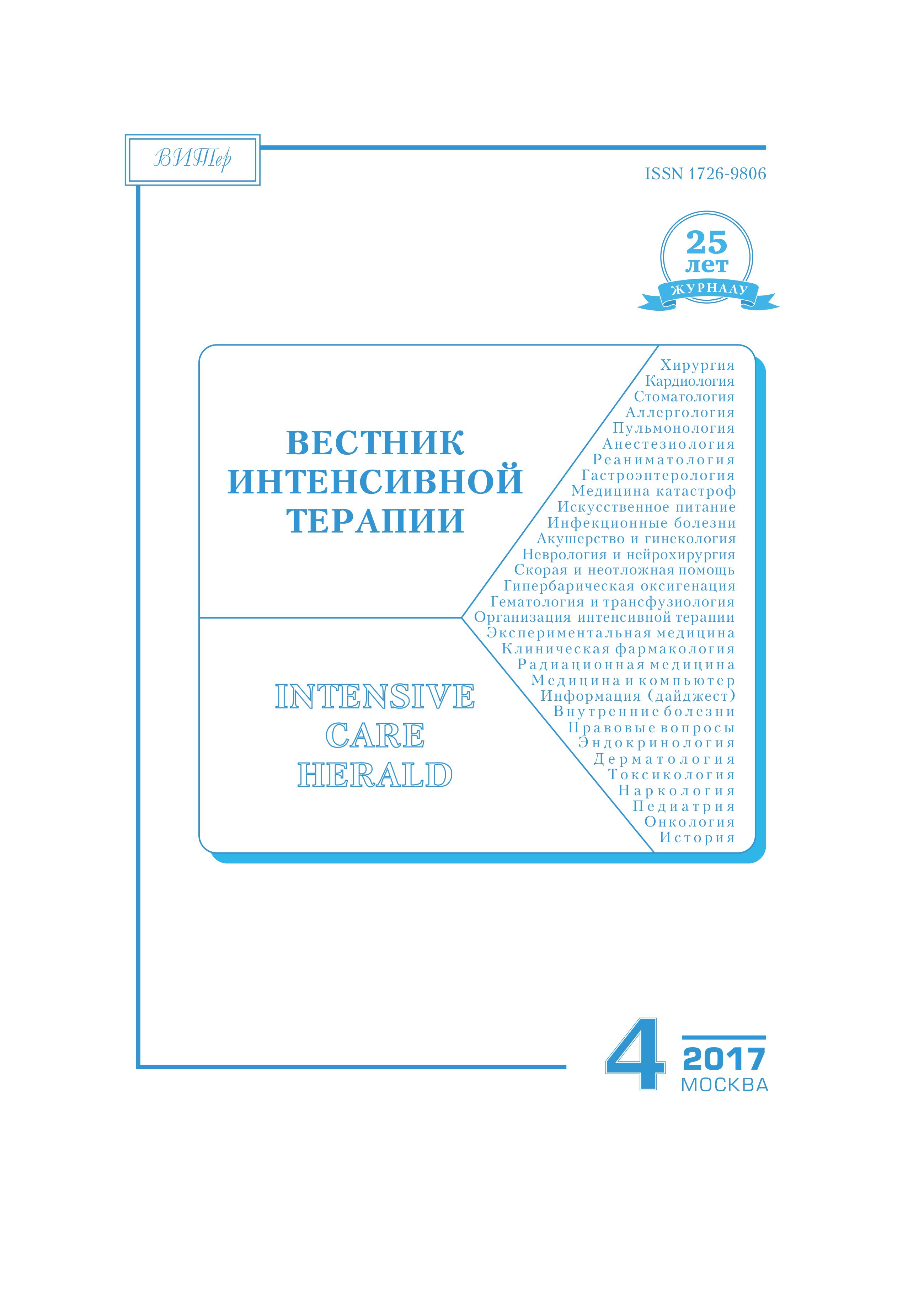Аннотация
Актуальность. Опросники STAI широко используются для измерения уровня тревожности. Количественное определение тревожности пациентов накануне операции может быть использовано при выборе наилучшего варианта премедикации. За основу взята англоязычная версия STAI-6, предназначенная для быстрого измерения ситуационной тревожности. Цели и задачи. Целью настоящего исследования является русская адаптация оригинальной шкалы-опросника STAI-6 и оценка возможности применения адаптированной STAI-6 для количественного определения уровня ситуационной тревожности. Материалы и методы. В исследовании приняли участие 104 пациента хирургического стационара, среди них 78 мужчин и 26 женщин. Тестирование проводилось накануне операции. Результаты. Анализ показал достаточный уровень надежности теста (а = 0,71), хороший уровень корреляции результатов (R = 0,894), а также текущую валидность и дискриминационную способность адаптированной STAI-6 в сравнении с полной STAI. При обработке результатов использованы непараметрические критерии Манна—Уитни, критерий Уилкоксона и коэффициент альфа Кронбаха. Выводы. Адаптированная STAI-6 позволяет произвести количественную оценку уровня ситуационной тревожности, сопоставимую с полной версией теста.
Библиографические ссылки
- Sheen M., Chang F., Ho S. Anesthetic premedication: New horizons of an old practice. Acta Anaesthesiologica 2014; 52(3): 134–142. doi: 10.1016/j.aat.2014.08.001.
- Ebirim L., Tobin M. Factors Responsible For Pre-Operative Anxiety In Elective Surgical Patients At A University Teaching Hospital: A Pilot Study. The Internet Journal of Anesthesiology. 2011; 29(2). doi: 5580/1584.
- Gale G., Gallon S. Lorasepam as a Canadian Anaesthetistsʼ Society Journal. 1976; 23(1): 22–29.
- Lanz E., Shafer M., Brunisholz V. Midazolam (Dormicum) as oral premedication for local anesthesia. Anaesthesist. 1987; 36(5): 197–202.
- Frank T., Wehner M., Heinke W., Schmadicke I. Clonidine vs Midazolam for premedication comparsion of the anxiolitic effect by using the STAI-test. Anästhesiologie· Intensivmedizin·Notfallmedizin· 2002; 37(2): 89–93. doi: 10.1055/s-2002-20395.
- Kazemisaeid A., Zeinali A., Davoodi G. et al. Premedication for coronary angiography: effects of anxiety and hemodynamic status. Indian heart Journal, 2007; 59(6): 454–458.
- Patel T., Kurdi M. A comparative study between oral melatonin and oral midazolam on preoperative on preoperative anxiety, cognitive, and psycho-motor functions. Journal of Anaesthesiology Clinical Pharmacology. 2015; 31(1): 37–43. doi: 4103/0970-9185.150534.
- Fioravanti-Bastos A., Cheniaux E., Landeira-Fernandez J. Development and Validation of a Short-Form Version of the Brazilian State-Trait Anxiety Inventory. Psicologia: Reflexão e Crítica. 2011; 24(3): 485–494. doi: 1590/s0102-79722011000300009.
- Lonner W. Assessment in cross cultural counseling. The counseling psychologist. 1985; 13(4): 599–614. doi: 1177/0011000085134004.
- McDowell J. Measuring Health: Guide to Rating Scales and Questionnaires. New York: Oxford university press,
- Piotrowski C. The status of the Beck Anxiety Inventory in contemporary research. Psychological Reports. 1999; 85(5): 261. doi: 2466/pr0.85.5.261-262.
- Spielberger C.D., Gorsuch R.L., Lushene R.E. et al. STAI manual of the Stait-Trait Anxiety Inventory (“self-evaluation questionnaire”). Palo Alto, California: Consulting Psychologists Press, 1970.
- Tluczek A., Henriques J., Brown R. Support for the relliability and validity of a six-item anxiety scale derived from the Statetrait anxiety invertory. Journal of Nursing Measurement. 2009; 17(1): 19–28. doi: 1891/1061-3749.17.1.19.
- Buela-Casal G., Guillén-Riquelme A. Short form of the Spanish adaptation of the State-Trait Anxiety Inventory. International Journal of Clinical and Health Psychology. 2017; 17(3): 261– 268. doi: 1016/j.ijchp.2017.07.003.
- Court H., Greenland K., Margrain T. Measuring patient an iety in primary care: rash analysis of the 6-item Spielberger State Anxiety Scale. Value in Health. 2010; 13(6): 813–819. doi: 1111/j.1524-4733.2010.00758.x.
- Macaluso A., Connelly A., Hayes W., Holub M., Ramsay M. et al. Oral transmucosal fentanyl citrate for premedication in Anesthesia and Analgesia. 1996; 82(1): 158–161. doi: 10.1097/00000539-199601000-00029.
- Rose P., Humm E., Hey K., Jones L., Huson S.M. Family history tacking and genetic counseling in primary Family Practice. 1999; 16(1): 78–83. doi: 10.1093/fampra/16.1.78.
- Ubhi S.S., Shaw P., Wright S., Stotter A., Clarke L. et al. Anxiety in patients with symptomatic breast disease: Effects of immediate versus delayed communication of results. Annals of the royal college of surgeons of England. 1996; 78: 466–469.
- Marteau T., Bekker H. The development of a six-item short-form of the state scale of the Spielberger State-trait Anxiety inventory (STAI). British Journal of Clinical Psychology. 1992; 31(3): 301–306. doi: 1111/j.2044-8260.1992.tb00997.x.
- Koizumi N., Fujita D., Ninomiya R., Nakamoto N. Screening test by statistically reducing the number of the State-Trait Anxiety Inventory (STAI) items. Sangyo Eiseigaku Zasshi. 1998; 40(4): 107–112. doi: 1539/sangyoeisei.kj00001990548.
- Van der Bij A., de Weerd S., Cikot R., Steegers E., Braspenning J. Validation of the Dutch short form of the state scale of the Spielberger State-Trait Anxiety Inventory: Considerations for usage in screening Public health genomics. 2003; 6(2): 84–87. doi: 10.1159/000073003.
- Micallef J., McGlangeaud-Freudenthal N., Aurran Y., Julian-Reynier C. Measurement of anxiety state in women: A shortform scale. Revue d’Epidemiologie et de Sante Publique. 1998; 46: 383–389.
- Pierce G., Sarason I., Sarason B. Social support questionnaire: Psychometrics, personality correlates and theory. Paper presented at the Western Psychological Association Convention. Washington,
- Jawaid M., Muschtaq A., Mukhtar S., Khan Z. Preoperative anxiety before elective surgery. Neurosciences (Riyadh). 2007; 12(2): 145–148.
- Perks A., Chakravarti S., Manninen P. Preoperative anxiety in neurosurgical patients. Journal Neurosurgical Anesthesiol 2009; 21(2): 127–130. doi: 10.1097/ana.0b013e31819a6ca3.
- Bekker H., Legare F., Stacey D., OʼConnor A., Lemyre L. Is anxiety an appropriate measure of decision aid effectiveness: a systematic review? Patient Education and 2003; 50(3): 255–262. doi: 10.1016/s0738-3991(03)00045-4.
- Bruggemann D., Schonhorst L., Conceicao M., Filho G. Heart Rate and Blood Pressure are not Good Parameters to Evaluate Preoperative Anxiety. Revista Brasileira Anestesiologia. 2004; 54( 6): 769–773.

Это произведение доступно по лицензии Creative Commons «Attribution-NonCommercial-ShareAlike» («Атрибуция — Некоммерческое использование — На тех же условиях») 4.0 Всемирная.
Copyright (c) 2017 ВЕСТНИК ИНТЕНСИВНОЙ ТЕРАПИИ имени А.И. САЛТАНОВА

